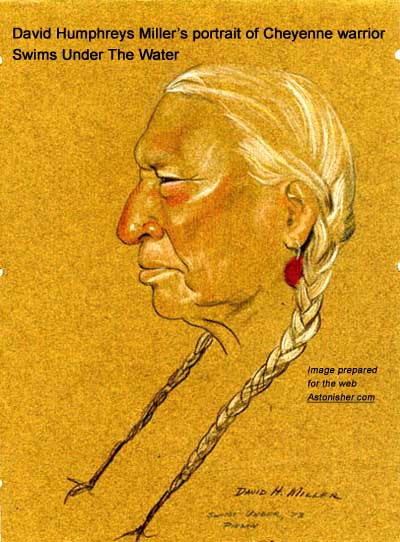|
||||||||||||
Bruce Brown's 100 Voices... Dives Backward, Rising Sun, Little Chief and Black Wolf's Story of the Battle
DIVES BACKWARD, RISING SUN, LITTLE CHIEF AND BLACK WOLF'S
A few live horses still limped downhill toward the river, their wounds obvious even at a distance. The women needed only a glance to assure them that the hopelessly injured animals were not worth bothering with. Another horse stood head down, unable to move. Under the dust and blood, he appeared to be a claybank gelding he was later identified as Comanche, Keogh's mount, supposedly the only living thing left on the field. His saddle had twisted under his belly and Monahseetah thought for a moment of taking the gold-edged blue saddle blanket. But it was mostly spoiled by bloodstains. Yellow Bird shouted at the horse and threw an earth clod his way, yet the animal would not move over. Nearby, a circle of dead horses and a pile of naked white bodies showed where the white troops had made a valiant stand. A Sioux warrior was engaged in cutting off the first joint of a dead soldier's finger. The two women moved closer and suddenly there was an exclamation of grief that halted the warrior. [Note: this is almost certainly White Cow Bull. Here is his account of trying to cut off the finger of a dead soldier who could be Custer just before two grieving squaws drove him off. There weren't too many squaws grieving over dead Americans that day! -- except Monaseetah.] "Ohohyaa!" The Sioux looked up sharply as he heard the name "Ouchess." Once in a council meeting Black Kettle had called the great white conqueror by that name. It meant Creeping Panther and was a name long unspoken by the tribesmen. Now standing above the body, Mahwissa had recognized in the dead soldier with the missing finger joint that same soldier-chief who had killed Black Kettle and wiped out the Southern Cheyenne camp on the Washita so many years ago. This had been the handsome dashing soldier who had once taken her niece and left her so that she could never have a Cheyenne husband. This was the father of little Yellow Bird. Mahwissa motioned the Sioux away. "He is our kinsman," she told him in the sign language, and he moved off, grinning over what he considered a grisly joke. He knew that sometimes Indian women cut off the genitals of a fallen foe, believing that by so doing greater fertility would come to the tribe. He looked back over his shoulder, thinking he would catch the two women busy at such a task. "Only one thing will we do," said Mahwissa, taking a bone sewing awl from her belt. Bending over Custer's body, she forced the sharp end of the awl into each ear of the corpse, jabbing deep. "So that Long Hair, the Creeping Panther, will hear better in the Spirit Land," she said by way of explanation. "He must not have heard our chiefs when they warned him if he broke his peace promise with them the Everywhere Spirit would surely cause him to be killed." [Note: White Cow Bull described this same scene with Monaseetah, Yellow Tail and the old squaw with the awl.] Monahseetah gazed in silence at the naked pale-skinned body she had once loved. Now, here in the dust and blood and stench, she felt nothing but loathing for the soldier-chief who had come to kill her people and had himself been slain. Custer's Fall: The Indian Side of the Story by David Humphreys Miller, University of Nebraska Press, Lincoln, NE 1957 p 168 - 170
David Humphreys Miller wrote of the Monaseetah story: "The story of Monahseetah and [Tom] Custer's son, Yellow Bird, was told to me by several Cheyenne informants including Black Wolf, Little Chief, Rising Sun, and Dives Backward of the Northern Cheyennes; and Eagle Nest and Yellow Eyes, both Southern Cheyennes... See White Cow Bull and Brave Bear's recollections of Monaseetah for more info. * * *
Miller frequenlty made pastel sketches of the Sioux survivors of the Battle of the Little Bighorn whom he interviewed. Some of Miller's portraits are exceptionally fine evocations of the historic personalities in their own right, such as his portraits of Lazy White Bull and Old Eagle and Black Elk late in life. Click here for information of David Humphreys Miller's sources among the Sioux, Cheyenne, Crow, Arikara and Apapaho. -- B.B.
|
||||||||||||




 Accompanied by her aunt Mahwissa, the sister of the dead Black Kettle, Monahseetah wandered idly over the field. Tagging at their heels, the little light-haired Yellow Bird followed. Scattered over the ridge, the carcasses of some seventy cavalry horses and two Indian ponies lay bloating in the heat. Soon they would get fly-blown and the stench would be too great on Battle Ridge for the people to come near. Mahwissa was already complaining of the heavy odor which clung in the warm still air.
Accompanied by her aunt Mahwissa, the sister of the dead Black Kettle, Monahseetah wandered idly over the field. Tagging at their heels, the little light-haired Yellow Bird followed. Scattered over the ridge, the carcasses of some seventy cavalry horses and two Indian ponies lay bloating in the heat. Soon they would get fly-blown and the stench would be too great on Battle Ridge for the people to come near. Mahwissa was already complaining of the heavy odor which clung in the warm still air. Although not born into the Teton Sioux, David Humphreys Miller was adopted late in life by both
Although not born into the Teton Sioux, David Humphreys Miller was adopted late in life by both 







